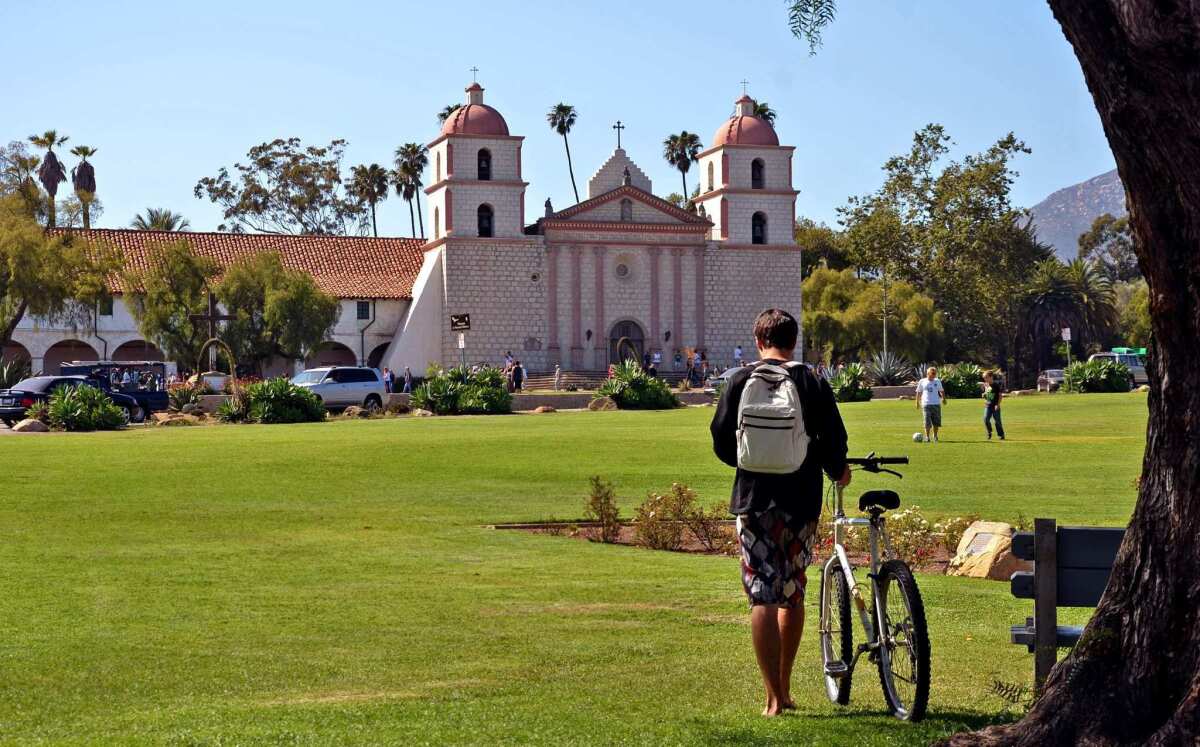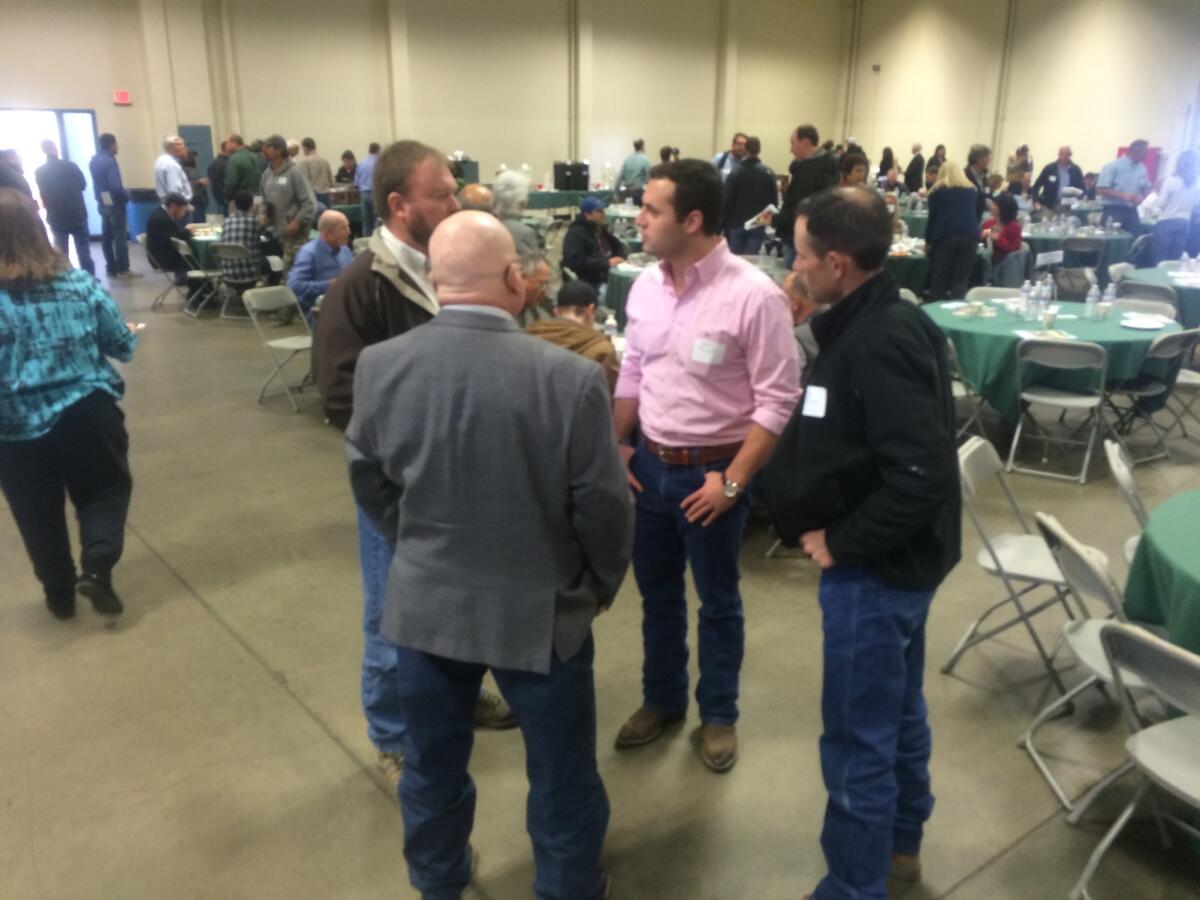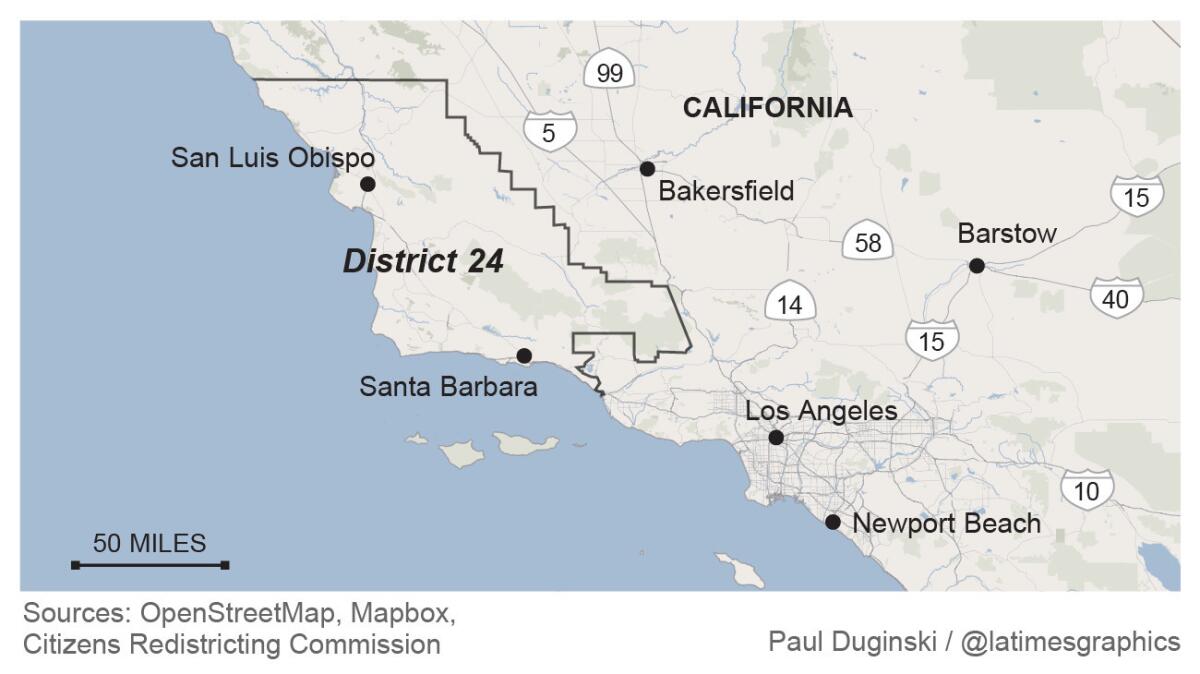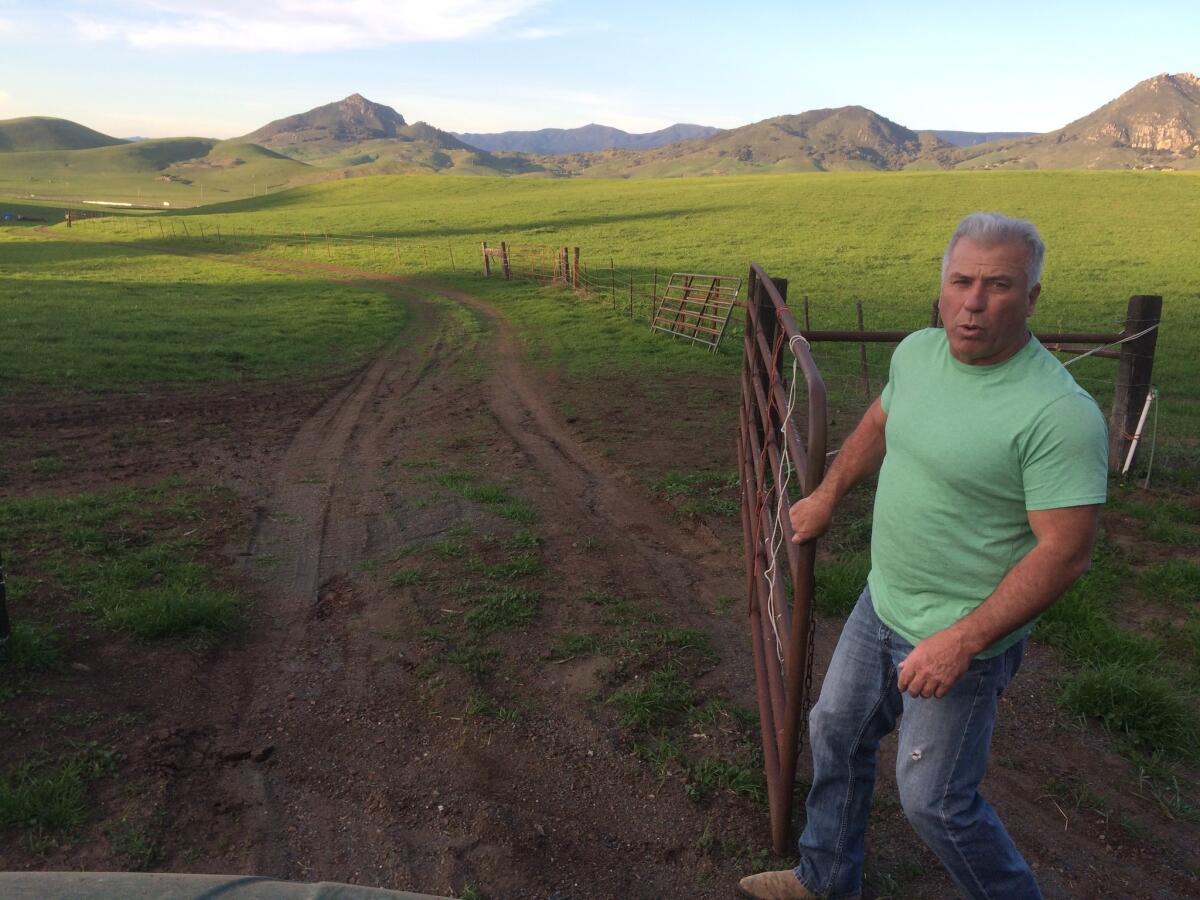A farmer and a former UCLA football player are running for Congress. Here’s why you should pay attention

- Share via
Judy Lundberg-Wafer scurried across the Santa Maria Fairplex convention center, cutting through the line for tri-tip at a agricultural forum on a path toward Justin Fareed, the former UCLA football player running to represent a large chunk of California's Central Coast in Congress.
Putting her arm around the 27-year-old Republican candidate, the petite vegetable farmer declared, "I'm impressed." As someone snapped a photo, she added, "But people need to get to know you. We need some up-and-comers."

Justin Fareed meets farmers and businessmen at an agricultural forum in Santa Maria. (Javier Panzar / Los Angeles Times)
Moments later, Fareed, a former Capitol Hill staffer who works for his family's sports medical devices company, was off to the next group, weaving around the lunch tables, shaking hands and passing out business cards as he went through the crowd at the forum here in the conservative stronghold of northern Santa Barbara County.
A few yards away, another congressional hopeful was also at work. Gas station owner and state Assemblyman K.H. "Katcho" Achadjian of San Luis Obispo posed for photos with farmers next to their produce displays. The candidates shook hands as they crossed paths near a bright red bouquet of radishes.
It is only February but this is a typical weekend in the Central Coast district as nine candidates have begun to press the flesh and work to earn recognition in a race that exemplifies California's "jungle" primary, in which the top two finishers advance to a general election.
The 24th Congressional District race to replace retiring Rep. Lois Capps (D-Santa Barbara) does not have a clear front-runner — and it's not a certainty which candidates will reach the threshold to appear on the November ballot, or if voters will give both a Republican and a Democrat the chance.
The race is attracting national attention from political operatives, wealthy donors and interest groups hoping to influence the result. Democrats tend to come out to vote in higher numbers during presidential election years, and the party has a 3-point advantage over Republicans among registered voters.
But since almost a quarter of voters state no party preference and a local tea party activist in 2014 came within 4 points of ousting Capps from the seat she had held since 1998, Republicans consider it a seat worth trying for.
Among the major Democrats running: a boisterous Latino Santa Barbara County supervisor favored by the party's establishment wing, the wonky mayor of Santa Barbara, and an actor-turned-hay-farmer running in the mold of Bernie Sanders
"It is a quintessential California race," GOP strategist Mike Madrid, who is not working for any of the campaigns, said of the diverse crop of candidates. "It is basically a coin toss on which way it goes, especially if Republicans spend money early and smart. All three of those [Democrats] are each pillars in the Democratic coalition."
SIGN UP for our free Essential Politics newsletter >>
The wide range of candidates fits the district, which spans nearly 200 miles of coast from Ventura to Ragged Point, north of San Luis Obispo, and runs inland to the Temblor Range at the edge of the San Joaquin Valley and south to Los Padres National Forest. Though the district has its share of coastal liberals and college students, there are also conservative voters among the ranchers and farmers in the inland area.

Democrat Salud Carbajal, a 12-year-veteran of the Santa Barbara County Board of Supervisors, has earned the backing of 82% of local delegates to the state party convention, three former Santa Barbara mayors and Capps herself. His depth of support was on display on a recent Saturday when fans packed into a stuffy former bagel shop on downtown Santa Barbara's main drag, State Street, to christen his campaign's headquarters. The cramped store was filled with just about every constituency — from newly recruited college students to old friends who had known Carbajal since his days as chief of staff to former county supervisor Naomi Schwartz in the 1990s. Carbajal smiled ear to ear as he walked the room with Capps, shaking hands.

Democratic Santa Barbara County Supervisor Salud Carbajal and Rep. Lois Capps (D-Santa Barbara) greet Cal Poly San Luis Obispo student Max Hokit. (Javier Panzar / Los Angeles Times)
For all his local support, it is Carbajal's institutional power — an endorsement from House Minority Leader Nancy Pelosi, for example — that is making him a force to be reckoned with in the race.
Rep. Tony Cardenas (D-Los Angeles), chairman of the Congressional Hispanic Caucus’ fundraising PAC, which contributed $10,000 to Carbajal's $1.38-million fundraising haul over the last year, strolled through the front door of the headquarters to offer his support later that day. The caucus wants to add to its ranks and considers Carbajal, who immigrated to the United States from Mexico with his parents when he was 5 and served in the military, a vital candidate to help them achieve that goal.
"He will make us feel good about being Americans," Cardenas told the crowd of supporters before they went out to walk precincts as temperatures pushed into the 70s on this particular Saturday.
About the only local Democrat not at the campaign headquarters was Helene Schneider, the mayor of Santa Barbara. That's because she is also running for the congressional seat, the only female candidate in the race.
She is running what her consultant calls an "insurgent campaign." Schneider worked for Planned Parenthood in human resources management and was president of the Santa Barbara Women’s Political Committee before she was elected to the city council and eventually to the mayoral seat in 2009.
She has suffered political defeats in recent years, including when she introduced a ballot measure to increase the city's sales tax and tackle rising pension costs only to abandon the plans after heated local resistance from unions and fellow liberals.
I'm not going to be someone who follows [the Democratic Party] lockstep on every vote and issue because someone tells me to.
Helene Schneider, Santa Barbara mayor
The move left some in the city with a bad taste in their mouths, said former mayor Marty Blum, who is supporting Carbajal but remains torn over not endorsing a fellow female.
"She is a woman -- I should be endorsing her," Blum said. "She is not as much of a team player. But she is wonderful. I could be speaking to you about her in July."
Schneider is seeking to use her executive experience and independent streak to contrast herself with Carbajal. During the first debate among candidates two weeks ago, she declared that she would not be a "yes man" on Capitol Hill.
"I'm not going to be someone who follows [the Democratic Party] lockstep on every vote and issue because someone tells me to," she said in an interview over Arnold Palmers at the Santa Barbara Fish House.
Schneider won't be a pushover in the primary. She has the endorsement of popular state Sen. Hannah-Beth Jackson (D-Santa Barbara) and Lt. Gov. Gavin Newsom. She and Carbajal were tied in a recent poll released by Achadjian's campaign, which showed the assemblyman with an 8-point lead over the Democrats with 20% of the vote. (Though the main takeaway was that 38% of those polled were undecided.)
Achadjian is longtime figure in San Luis Obispo County politics. His parents survived the Armenian genocide and settled in Lebanon before he came the U.S. to study at Cal Poly San Luis Obispo. He bought a string of gas stations and got into local politics. His office is on the second floor of a custom-built mini-mart at one of those stations just off U.S. Highway 101 in the small coastal town of Arroyo Grande. It is covered with plaques and kitschy awards (including a pair of large ceramic roosters from a local art auction) from local clubs he won during his time as a county supervisor.
Though he has a conservative voting record in Sacramento (with a perfect score from the California Chamber of Commerce and siding with the California Labor Federation just 7% of the time, according to the California Target Book, a nonpartisan research document), he is known around the community for his moderate temperament and dedication to constituent services, said Michael Latner, an associate professor of political science at Cal Poly San Luis Obispo who is active in local politics. Achadjian drives his own SUV 300 miles to Sacramento and back every week. At the debate, he used his closing statement to flash a framed copy of a local newspaper editorial calling him a "shepherd of consensus."
Fareed, the other top GOP contender, is billing himself as the "next generation" of Republican leadership in California. He has hired a top-shelf campaign staff, including veterans of Wisconsin Gov. Scott Walker's presidential campaign, and boasts a growing campaign war chest.
Then there is San Luis Obispo hay farmer William Ostrander. He was an actor in the '80s — look for him in the 1983 film adaptation of Stephen King's cult classic "Christine" about the killer car — before he worked as conservation activist in Africa.
Now he is running his campaign for Congress out of a former cow-milking station he turned into a studio on a more than 300-acre farm, with a focus on campaign finance reform and taxing certain Wall Street transactions. He doesn't shy away from comparisons to Sanders, and says the "Feel the Bill" bumper stickers he ordered have just arrived.

Congressional candidate and farmer William Ostrander opens a gate on his farm. (Javier Panzar / Los Angeles Times)
At the debate, Ostrander exuded energy, standing up as he gave his answers. He earned a healthy response from members of the crowd when asking them to raise their hands if they felt there is too much money in politics.
Ostrander said he isn't accepting money from political action committees and hasn't so far, according to federal records. Instead, he is trying to tap into the same networks activating around Sanders' presidential campaign, both locally and online. A pro-Sanders concert last week netted him 90 signatures from young people interested in volunteering for his campaign, he said.
On a recent ride around the property, Ostrander pointed to the knee-high grass growing and mentioned with pride that food activist and author Michael Pollan had recently tweeted out a link to a page on Ostrander's campaign's website dealing with climate change and sequestering carbon underground.
Ostrander has hardly registered in early polls and had the least money in the bank of the five candidates in the race who had filed campaign finance paperwork with the Federal Elections Commission. But he said that if Sanders' message continues to resonate with voters ahead of the June 7 California primary and the congressional race stays crowded, he is banking on a wave of progressive voters to help him along.
"I do intend to win this thing," he said.
Follow @jpanzar
For more, go to latimes.com/politics
ALSO
Why activists in these California swing districts are feuding with the national Democratic Party
Celebrity donors pour money into this open California congressional seat
As Porter Ranch gas leak lingers, candidates smell a political opportunity
Get the L.A. Times Politics newsletter
Deeply reported insights into legislation, politics and policy from Sacramento, Washington and beyond. In your inbox three times per week.
You may occasionally receive promotional content from the Los Angeles Times.








